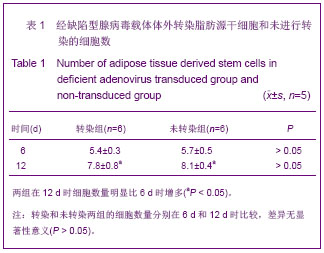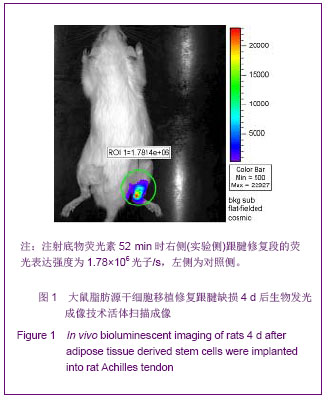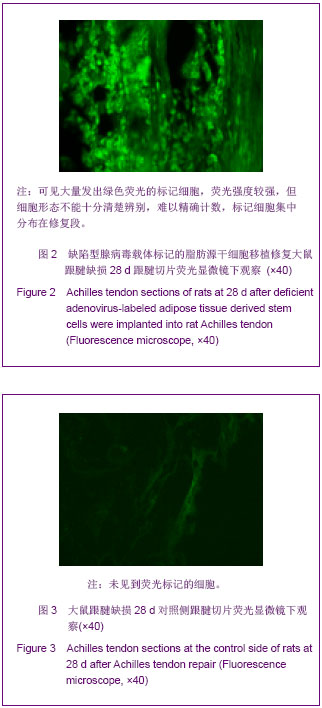| [1]Lee SK. Modern tendon repair techniques. Hand Clin. 2012; 28(4):565-570.[2]Karabekmez FE, Zhao C. Surface treatment of flexor tendon autograft and allograft decreases adhesion without an effect of graft cellularity: a pilot study. Clin Orthop Relat Res. 2012; 470(9):2522-2527.[3]Dy CJ, Daluiski A, Do HT, et al. The epidemiology of reoperation after flexor tendon repair. J Hand Surg Am. 2012; 37(5):919-924.[4]Griffin M, Hindocha S, Jordan D, et al. An overview of the management of flexor tendon injuries. Open Orthop J. 2012;6:28-35. [5]Butler DL, Awad HA. Perspectives on cell and collagen composites for tendon repair. Clin Orthop Relat Res. 1999; (367 Suppl):S324-332.[6]Zuk PA, Zhu M, Mizuno H,et al.Multilineage cells from human adipose tissue: implications for cell-based therapies. Tissue Eng. 2001;7(2):211-228.[7]Shen JF, Sugawara A, Yamashita J, et al. Dedifferentiated fat cells:an alternative source of adult multipotent cells from the adipose tissues. Int J Oral Sci. 2011;3(3):117-124.[8]Levi B, Longaker MT. Concise review:adipose-derived stromal cells for skeletal regenerative medicine. Stem Cells. 2011;29(4):576-582.[9]Hou K, Li M, Li JR, et al. Zhongguo Xiandai Yisheng Zazhi. 2011;21(8):929-933.侯凯,李梅,李金茹,等.体外诱导大鼠脂肪源间充质干细胞成肌腱潜能的研究[J].中国现代医学杂志,2011,21(8):929-933.[10]Leo BM, Li X, Balian G, et al. In vivo bioluminescent imaging of virus-mediated gene transfer and transduced cell transplantation in the intervertebral disc. Spine. 2004; 29(8): 838-844.[11]Murphy KD, Mushkudiani IA, Kao D, et al. Successful incorporation of tissue-engineered porcine small-intestinal submucosa as substitute flexor tendon graft is mediated by elevated TGF-beta1 expression in the rabbit. J Hand Surg Am. 2008;33(7):1168-1178.[12]Hou K, Li M, Yang YK, et al. Zhongguo Zuzhi Gongcheng Yanjiu yu Linchuang Kangfu. 2011;15(1):29-32.侯凯,李梅,杨逸昆,等. SD大鼠脂肪源间充质干细胞分离培养特性及影响因素[J].中国组织工程研究与临床康复,2011,15(1): 29-32.[13]Galle J, Bader A, Hepp P, et al. Mesenchyal stem cells in cartilage repair: state of the art and methods to monitor cell growth, differentiation and cartilage regeneration. Curr Med Chem. 2010;17(21):2274-2291.[14]Togel F, Yang Y, Zhang P, et al. Bioluminescent imaging to mornitor the in vivo distribution of mesenchyal stem cells in acute kidney injury. Am J Physiol Renal Physiol. 2008;295 (1):315-321. [15]Hwang do W, Jang SJ, Kim YH, et al. Real-time in vivo monitoring of viable stem cells implanted on biocompatible scaffolds. Eur J Nucl Med Mol Imaging. 2008;35(10): 1887-1898. [16]Li HX, Zhou YF, Jiang B, et al. Yixue Yanjiusheng Xuebao. 2013;26(3):228-231.李红霞,周亚峰,蒋彬,等.大鼠骨髓间充质干细胞转染GATA-4的表达及鉴定[J].医学研究生学报,2013,26(3):228-231.[17]Wang Q, Chen GX, Guo L, et al. Zhonghua Shiyan Waike Zazhi. 2013;30(3):599-601.王庆,陈光兴,郭林,等. 腺病毒介导的骨形态发生蛋白-2和骨形态发生蛋白-7基因联合转染大鼠脂肪来源干细胞对成骨分化的影响[J]. 中华实验外科杂志,2013,30(3):599-601.[18]Li Y, Tian Y, Wu ZC, et al. Zhongguo Zuzhi Gongcheng Yanjiu. 2012;16(41):7607-7611.李洋,田瑜,武志超,等.稳定转染增强型绿色荧光蛋白大鼠骨髓间充质干细胞系的建立[J].中国组织工程研究, 2012,16(41): 7607-7611.[19]Duan L, Song ZG, Gong DJ, et al. Jiepouxue Zazhi. 2012; 35(4):431-435.段炼,宋智钢,龚德军,等.腺病毒介导HCN2基因转染对人脂肪干细胞生物学特性的影响[J].解剖学杂志, 2012,35(4):431- 435.[20]Luker KE, Luker GD. Applications of bioluminescence imaging to antiviral research and therapy: multiple luciferase enzymes and quantitation. Antiviral Res. 2008;78(3):179-187. [21]Prinz A, Reither G, Diskar M, et al. Fluorescence and bioluminescence procedures for functional proteomics. Proteomics. 2008;8(6):1179-1196.[22]Feng G, Wan Y, Balian G, et al.Adenovirus-mediated expression of growth and differentiation factor-5 promotes chondrogenesis of adipose stem cells. Growth Factors. 2008;26(3):132-142.[23]Hou Y, Mao Z, Wei X, et al. Effects of transforming growth factor-beta1 and vascular endothelial growth factor 165 gene transfer on Achilles tendon healing. Matrix Biol. 2009;28(6): 324-335. [24]Shao L, Wu WS. Gene-delivery systems for iPS cell generation. Expert Opin Biol Ther. 2010;10(2):231-42.[25]Kyritsis AP, Sioka C, Rao JS. Viruses, gene therapy and stem cells for thetreatment of human glioma. Cancer Gene Ther. 2009;16(10):741-752. [26]Chen J, Yuan W, Song DW, et al. Zhongguo Zuzhi Gongcheng Yanjiu. 2012;16(49):9139-9145.陈剑,袁文,宋滇文,等.骨形态发生蛋白2和7共转染骨髓间充质千细胞的成骨分化[J].中国组织工程研究,2012,16(49): 9139-9145.[27]Wang DL, Xing DG, Wu JJ, et al. Zhonghua Chuangshang Zazhi. 2012;28(11):1042-1045.王德亮,邢德国,吴建军,等. 骨形态发生蛋白-2基因转染骨髓间充质干细胞移植对糖尿病大鼠骨折愈合的影响[J]. 中华创伤杂志,2012,28(11):1042-1045.[28]Huang D, Balian G, Chhabra AB. Tendon tissue engineering and gene transfer: the future of surgical treatment. J Hand Surg Am. 2006;31(5):693-704.[29]Murray SJ, Santangelo KS, Bertone AL. Evaluation of early cellular influences of bone morphogenetic proteins 12 and 2 on equine superficial digital flexor tenocytes and bone marrow-derived mesenchymal stem cells in vitro. Am J Vet Res. 2010;71(1):103-114. [30]Hou Y, Mao Z, Wei X, et al. Effects of transforming growth factor-beta1 and vascular endothelial growth factor 165 gene transfer on Achilles tendon healing. Matrix Biol. 2009; 28(6): 324-335. [31]Thorfinn J, Saber S, Angelidis IK, et al. Flexor tendon tissue engineering: temporal distribution of donor tenocytes versus recipient cells.Plast Reconstr Surg. 2009;124(6):2019-2026.[32]Hogan MV, Bagayoko N, James R, et al. Tissue engineering solutions for tendon repair. J Am Acad Orthop Surg. 2011; 19(3):134-142. [33]Wang HG, Li HM, Liu DL, et al. Zhongguo Zuzhi Gongcheng Yanjiu. 2013;17(1):106-111.王和庚,黎洪棉,柳大烈,等.缺氧诱导因子1α基因转染脂肪干细胞与自体脂肪移植[J].中国组织工程研究,2013,17(1): 106-111.[34]Sun L, Tian XB, Hu RY, et al. Zhongguo Zuzhi Gongcheng Yanjiu. 2012;16(27):5017-5021. 孙立,田晓滨,胡如印,等. plRES-骨形态发生蛋白2质粒转染大鼠骨髓间充质干细胞后的持续表达[J].中国组织工程研究,2012, 16(27):5017-5021.[35]Guo WT, Wang H, Liu SJ, et al. Zhongguo Zuzhi Gongcheng Yanjiu. 2012;16(23):4273-4427.郭伟韬,王辉,刘思景,等.人骨形态发生蛋白2和人成纤维细胞生长因子2双基因共表达腺病毒载体转染人骨髓基质干细胞[J]. 中国组织工程研究,2012,16(23):4273-4427.[36]Han D, Xu H, Zheng YX, et al. Zhongguo Shiyan Zhenduanxue. 2012;16(5):766-769.韩冬,徐煌,郑永霞,等. Klotho基因转染促进脂肪间充质干细胞增殖的实验研究[J].中国实验诊断学,2012,16(5):766-769.[37]Dong F, Chen HH, Yang XH, et al. Zhongguo Jiaoxing Waike Zazhi. 2010,19:1631-1634.董飞,陈鸿辉,杨小红,等.骨髓间充质干细胞促进骨-肌腱结合部位早期愈合的动物生物力学实验研究[J].中国矫形外科杂志, 2010,25(19):1631-1634.[38]Butler DL, Gooch C, Kinneberg KR, et al. The use of mesenchymal stem cells in collagen-based scaffolds for tissue-engineered repair of tendons. Nat Protoc. 2010; 5(5):849-863.[39]Grange S. Current issues and regulations in tendon regeneration and musculoskeletal repair with mesenchymal stem cells. Curr Stem Cell Res Ther. 2012;7(2):110-114. [40]Yin Z, Chen X, Chen JL, et al. Stem cells for tendon tissue engineering and regeneration. Expert Opin Biol Ther. 2010; 10(5):689-700. [41]Park A, Hogan MV, Kesturu GS, et al. Adipose-tissue derived mesenchyal stem cells treated with growth differentiation factor-5 express tendon-specific markers. Tissue Eng Part A. 2010;16(9):2941-2951.[42]Uysal AC, Mizuno H. Tendon regeneration and repair with adipose derived stem cells. Curr Stem Cell Res Ther. 2010; 5(2):161-167. |



.jpg)